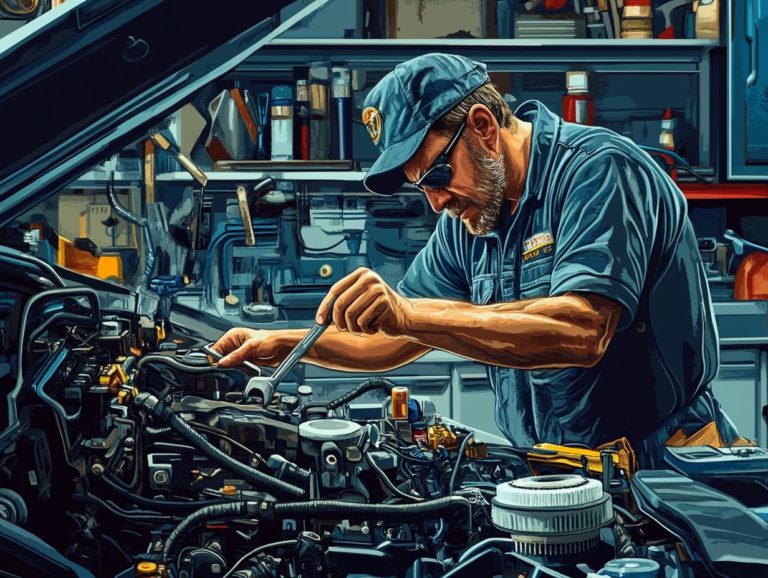Transmission Troubles: Common Fixes Explained
When it comes to your vehicle, the transmission is essential for ensuring a smooth ride. Transmission troubles can emerge when you least expect them, resulting in frustrating and costly repairs.
This guide outlines common symptoms and causes of transmission issues, enabling you to identify problems with confidence. You ll discover practical solutions, maintenance tips to help prevent future complications, and valuable insight on when it s time to seek professional assistance.
Get ready to equip yourself with knowledge that can save you both time and money!
Contents
Key Takeaways:
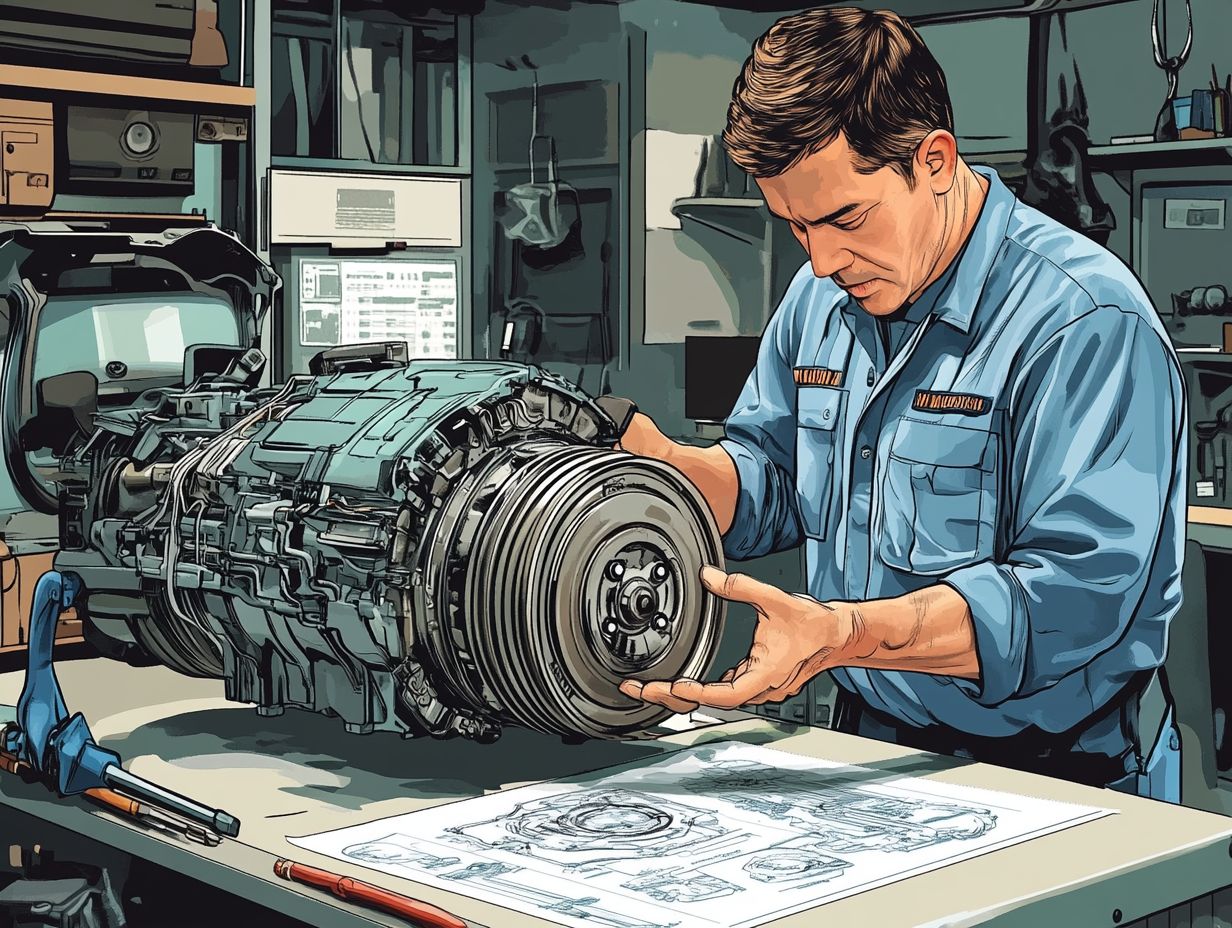
- Regular maintenance and proper care can prevent transmission issues.
- Watch out for common transmission issues like fluid leaks, burnt-smelling fluid, and slipping gears.
- When diagnosing transmission problems, use the right tools and techniques to accurately identify the issue.
Understanding Transmission Troubles
Understanding transmission troubles is crucial for vehicle owners. It ensures that your automatic, manual, or CVT transmission operates at its best.
Common issues like fluid leaks, overheating, or strange noises often signal deeper problems within the transmission system. Ignoring these signs could lead to serious failures, resulting in costly repairs that require the expertise of a professional mechanic.
Recognizing these symptoms can empower you to take action and keep your transmission in top shape! By grasping their underlying causes, you can take proactive steps to maintain your transmission system, ultimately ensuring safer and more reliable driving conditions.
Common Symptoms and Causes
Common symptoms of transmission troubles include gear slipping, poor gear engagement, and unusual noises, all of which can stem from various issues affecting the transmission fluid and components.
In addition to these signs, you might notice the check engine light flickering on. This could indicate potential electronic glitches or faulty sensors lurking within the system.
Fluid leaks are another concern whether they arise from worn seals or gaskets, they can cause significant drops in transmission efficiency if not addressed swiftly.
If you notice clutch issues, don t wait! Address them immediately to avoid bigger problems. Symptoms like difficulty engaging gears or a spongy pedal feel often signal wear and tear on critical components. Ignoring these signs could lead to more serious complications down the road.
Being aware of these symptoms gives you the power to seek timely repairs, ensuring a smoother and safer driving experience.
Diagnosing Transmission Issues
Diagnosing transmission issues demands a comprehensive understanding of the intricate transmission system, complemented by special tools that help find problems impacting vehicle performance.
It’s important to engage a professional mechanic to diagnose issues, as they utilize a range of methods to accurately pinpoint the root causes of the problems, whether they pertain to the torque converter, solenoids, or other vital components.
Diagnostic Techniques and Tools
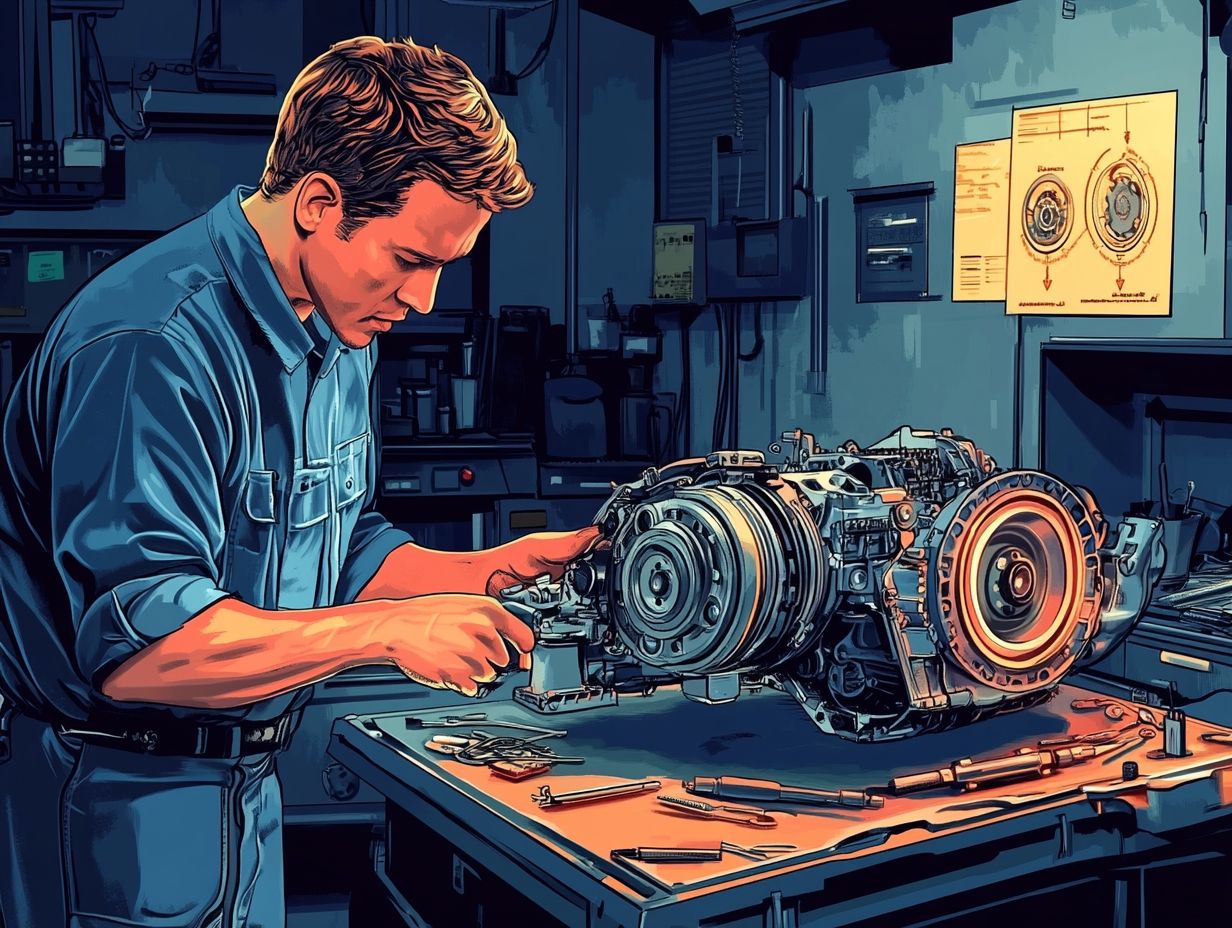
Effective diagnostic techniques and tools are essential for you to identify transmission issues, including assessing sensors and solenoids to ensure the system operates flawlessly.
By utilizing advanced scan tools, you can efficiently read and analyze error codes, providing valuable insights into what s happening beneath the hood. Pressure gauges are also critical, helping you assess hydraulic pressures within the transmission and pinpoint any irregularities that may indicate a malfunction.
Leveraging these diagnostic instruments allows you to transform routine inspections into a proactive maintenance strategy, ensuring that any anomalies are addressed before they escalate into significant problems. This comprehensive approach not only enhances the performance of your transmission but also extends your vehicle’s lifespan, fostering reliability on the road.
Common Fixes for Transmission Problems
Common solutions for transmission issues typically include:
- Replacing fluids and filters crucial for optimal transmission performance.
- Tackling any clutch-related concerns necessary for smooth gear engagement.
- Repairing or replacing malfunctioning solenoids or other essential components within the transmission system.
Replacing Fluids and Filters
Replacing transmission fluid and filters is crucial for maintaining your vehicle s transmission. This ensures smooth operation and helps prevent potential fluid leaks that could lead to more serious issues.
It’s important to understand the different types of transmission fluid, including automatic and manual. Each type plays a specific role in optimizing performance. These fluids lubricate, clean, and cool the internal components of your transmission system.
Regular maintenance, including timely fluid changes typically every 30,000 to 60,000 miles significantly reduces the risk of breakdowns and enhances your vehicle’s longevity. Neglecting filters can lead to sludge accumulation, compromising fluid efficiency.
By taking proactive maintenance steps, you can ensure your transmission operates efficiently, ultimately extending its performance and lifespan.
Repairing or Replacing Parts
Repairing or replacing worn components like the solenoid, clutch, and torque converter is essential for restoring full functionality to your transmission and preventing future issues.
These critical parts work together to ensure smoother gear shifting and efficient power transfer from the engine to the wheels. Recognizing early signs of wear such as slipping gears, delayed engagement, or unusual noises can help you avoid extensive damage that might lead to costly repairs.
Ignoring these indicators could decrease vehicle performance, reduce fuel efficiency, and add strain on other system components.
Regular inspection of these elements is advantageous. Timely intervention significantly enhances the longevity of your transmission and maintains your vehicle’s overall health.
Preventing Transmission Troubles
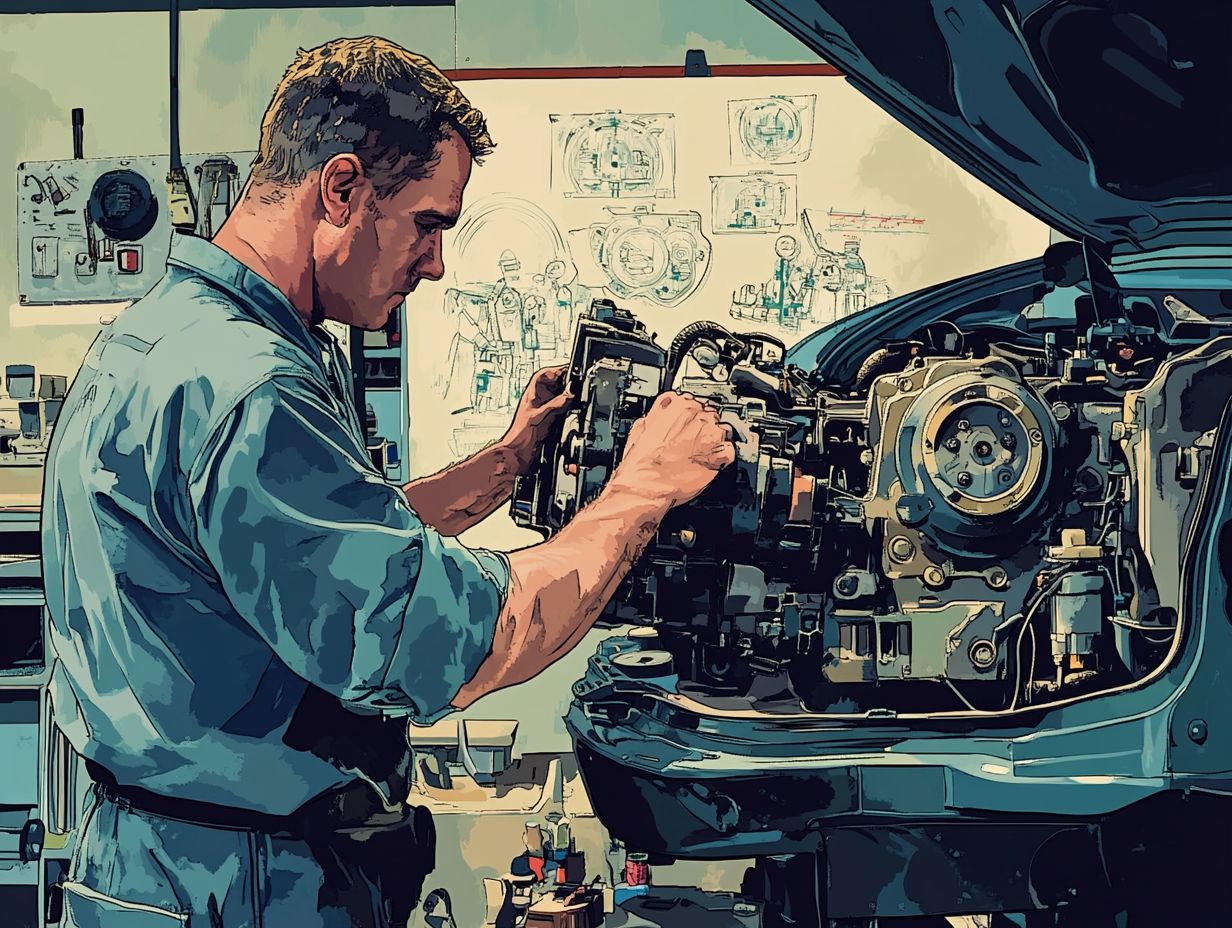
Preventing transmission troubles means embracing savvy maintenance tips and best practices that enhance the longevity and reliability of your transmission system.
This includes routinely checking your transmission fluid levels and conducting thorough safety inspections. Taking these proactive steps ensures a smoother, more dependable ride for years to come.
Maintenance Tips and Best Practices
Implementing maintenance tips and best practices like regularly checking your transmission fluid and conducting thorough safety inspections can drastically reduce the risk of transmission issues.
Being proactive in these areas significantly enhances the longevity of your transmission and ensures a smoother driving experience. Schedule fluid changes every 30,000 to 60,000 miles, tailored to your specific vehicle and driving conditions, for optimal performance. A comprehensive inspection of the transmission system should be performed semi-annually, while keeping an ear out for any unusual sounds or shifting delays.
If persistent problems arise, don’t wait seek a professional mechanic immediately! Addressing minor issues before they escalate can save you from costly complications and safeguard your investment.
When to Seek Professional Help
Understanding when to seek professional assistance is essential for vehicle owners. Specific indicators, such as persistent noises, fluid leaks, and warning lights, signal that immediate attention from a qualified mechanic is imperative.
Addressing these transmission issues promptly makes a significant difference in your vehicle’s performance and longevity.
Signs That You Need a Mechanic
Common signs that you need to consult a mechanic include:
- Check engine light
- Slipping gears
- Unusual noises
- Visible fluid leaks
These signs indicate potential vehicle issues. Each symptom can be a warning of problems within your vehicle’s complex parts.
The check engine light may seem like a minor annoyance, but it can signal catastrophic damage if ignored. Slipping gears can also reduce efficiency and lead to costly repairs. Unusual noises might indicate loose parts or misalignment, while fluid leaks are a glaring sign of deteriorating seals or gaskets.
Addressing these signs promptly is essential. Consult a mechanic quickly to save both time and money!
Frequently Asked Questions
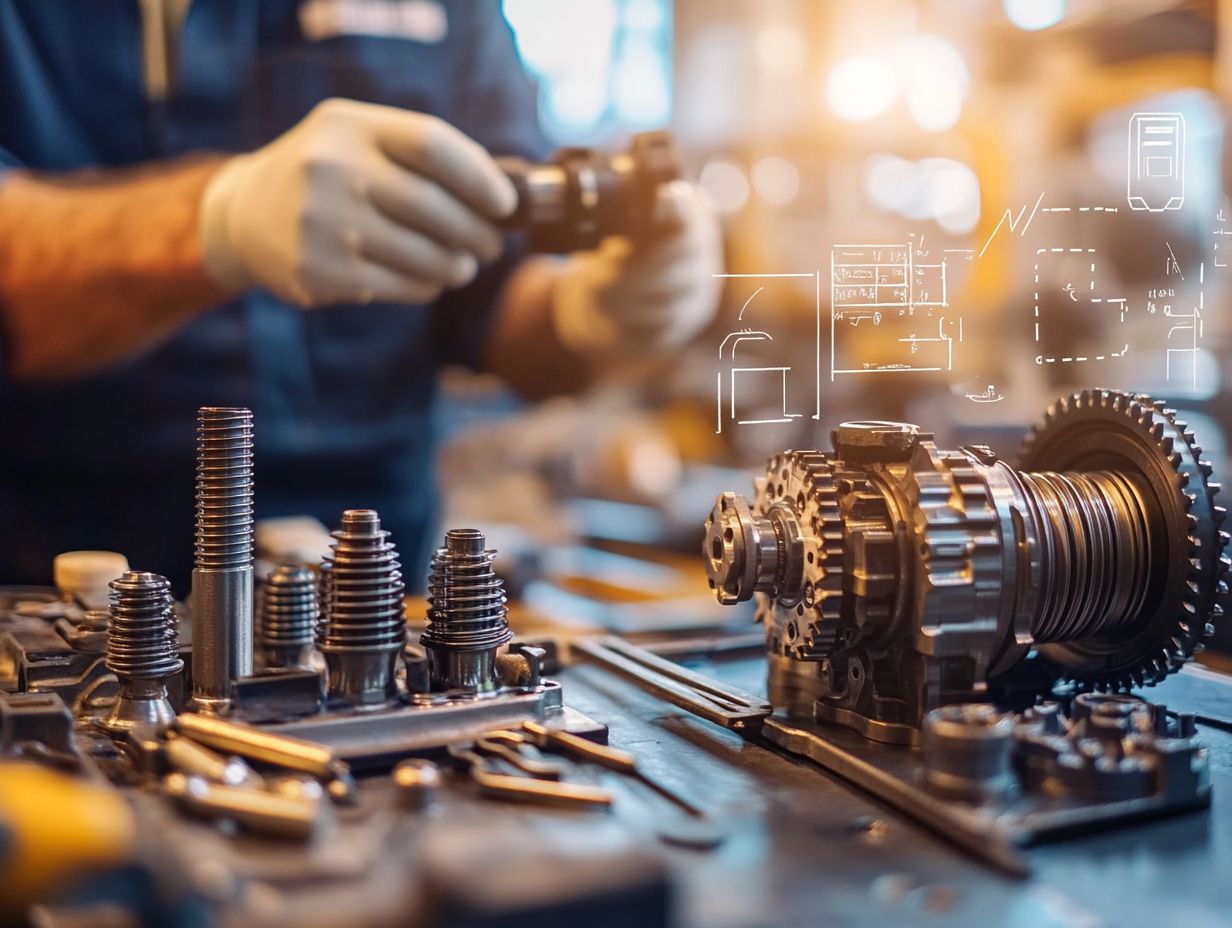
What are some common transmission troubles?
Common transmission troubles include:
- Slipping gears
- Delayed shifts
- Transmission fluid leaks
- Strange noises
How can I fix slipping gears?
Slipping gears can be caused by low or dirty transmission fluid, worn clutch plates, or a faulty torque converter. To fix this, check and replace the transmission fluid, or have a professional mechanic diagnose and repair the issue.
What causes delayed shifts?
Delayed shifts can be due to a faulty shift solenoid, low transmission fluid, or a worn clutch. Have a mechanic check these components and replace any that are damaged.
What should I do if I notice a transmission fluid leak?
If you notice a transmission fluid leak, check the fluid levels and top off if necessary. Then, have a mechanic inspect the transmission for any cracks or damaged seals that may be causing the leak.
Why am I hearing strange noises when my transmission shifts?
Strange noises during shifting could be a sign of worn gears, a damaged flywheel, or low transmission fluid. Have a mechanic inspect and replace any damaged components.
Can I fix transmission troubles on my own?
Minor transmission issues, such as low fluid levels, can be fixed on your own. However, for more complex issues, it is best to seek help from a professional mechanic who has the proper tools and knowledge to diagnose and repair the problem.




